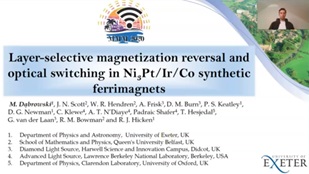
Layer-selective magnetization reversal and optical switching in Ni3Pt/Ir/Co synthetic ferrimagnets
M. Dabrowski, J.N. Scott, W.R. Hendren, A. Frisk, D.M. Burn, P.S. Keatley, D.G. Newman, C. Klewe, A.T. N’Diaye, P. Shafer, T. Hesjedal, G. van der Laan, R.M. Bowman and R.J. Hicken
Magnetism and Magnetic Materials Online November 2020
Synthetic ferrimagnets and antiferromagnets with perpendicular anisotropy have attracted great interest as they allow for stabilization of room-temperature skyrmions 1, fast domain wall motion 2, and all-optical switching of magnetization 3. Here we study Ni3Pt/Ir/Co structures in the vicinity of the compensation point temperature TM, where the magnetizations of the two layers have the same magnitude and are anti-parallel to each other. By measuring element-specific hysteresis loops using x-ray magnetic circular dichroism (XMCD) and wide-field magneto-optical Kerr effect (MOKE) microscopy, we explore the magnetization reversal and domain structure of the Ni3Pt and Co layers (Fig. 1). We show that the change of the magnetic state upon increasing the temperature through the compensation point is a continuous transition, associated with formation of a domain structure at remanence. Furthermore, we show that increasing the magnetic field sweep rate between saturation and remanence changes the mechanism of the magnetization reversal from propagation of domain walls to nucleation of reverse domains. Finally, we demonstrate how the layers can be switched by optical laser pulses, with the assistance of a small external magnetic field (down to 1 mT). The Ni3Pt/Ir/Co structures are promising candidates for all-optical control of magnetism in rare-earth-free synthetic ferrimagnets.
[1] W. Legrand et al., Nature Materials 19, 34-42 (2020).
[2] S.-H. Yang et al., Nature Nanotechnology 10, 221-226 (2015).
[3] J. W. Liao et al., Advanced Science 1901876 (2019).